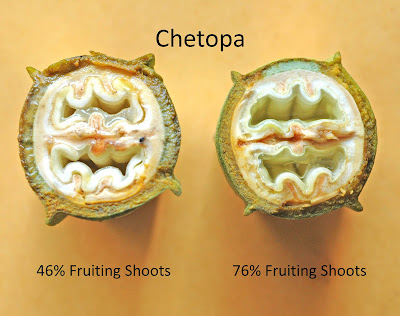This summer, we have been looking at the influence of crop load on nut production, especially during this year's drought. Today, I collected a few nut samples in this trial to check on the progress of nuts growing on Giles and Chetopa trees. I selected two trees from each cultivar; each tree with widely differing crop loads.
The photo at right shows Giles nuts collected from a tree with a light crop (28% fruiting shoots) vs. nuts collected from a tree with a good crop (60% fruiting shoots). Its easy to see that the tree with a smaller crop load had larger pecans.
This summer our Chetopa trees have a greater overall crop than the Giles trees but you can still see a difference in nut size between the tree with the small crop load (46% fruiting shoots) and a large crop (76% fruiting shoots). Again, fewer nuts on the tree results in larger nut size.
The simple relationship between crop load and nut size means that pecan trees can partially compensate for yield loses associated with a weaker nut set by growing bigger pecans.
I also cut into all the nuts I collected to check on kernel development and was somewhat surprised at what I found. Giles kernel development was far more advanced on the light crop load tree as compared to the good crop load tree (photo at right). Could it be that, in this year of short water supply, the tree with the good crop was "waiting" for more water before it could begin to fill the kernel?
I cut into the Chetopa nuts and found a similar trend although not as striking (photo at right). Kernel development was farther along on a tree with a lighter crop load. To fully understand the kernel filling process check out this post.
It will be interesting to see if the differences in nut develop present in mid-August will be visible as differences in kernel quality come this November (harvest time).



